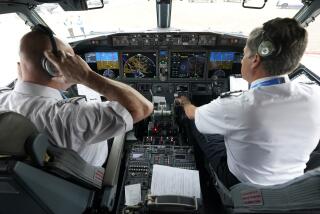Wizards of OZ Have Better Idea for Pilots
- Share via
PENSACOLA, Fla. — Pilots flying on instruments when the sky is too dark, cloudy or stormy to see the ground must slow their procedures while they scan myriad gauges one at a time and determine the significance of each number.
“The question is why?” said vision scientist David Still. “The pilot’s the same. The airplane’s the same. The atmosphere’s the same. The only difference is how the pilot’s getting information about how things are going.”
Still and his research partner, Leonard Temme, believe that they have a better idea in OZ, a computerized system that provides pilots with a symbolic picture of how things are going without asking them to slow down to read instruments.
OZ would replace cockpit gauges with a computer screen that uses lines, circles and streaming “stars” to graphically show where an airplane is going, how fast and high it is flying, and other vital data in one glance.
Still, a researcher at the University of West Florida’s Institute for Human and Machine Cognition, and Temme, a vision scientist with the Naval Aerospace Medical Research Laboratory, are the wizards of this OZ. They met when Still, now a retired Navy commander, worked in the medical research lab at Pensacola Naval Air Station.
The system got its name because the scientists borrowed a line from “The Wizard of Oz” during an early experiment that used a rear-projection screen to vary the size of the viewing panel.
“You had to get behind the screen and turn on the projector,” Still said. “So we would tell people not to pay attention to the man behind the curtain.”
OZ grew from research Still conducted for his PhD in physiological optics at Indiana University. It showed that peripheral vision is vital for preventing people from bumping into things.
Numbers on conventional instruments can be read only with straight-on vision, but OZ’s symbolic data capitalizes on what the eye and brain see best, quickest and easiest, Still said.
Streaming dots, or stars, create an artificial sky through which a pilot flies an “aircraft metaphor” of lines and circles that reflect speed, direction, attitude, engine power and other performance data. The graphics also show how close the plane is to stalling or other dangerous conditions, Still said.
“The display has all the information you need in one quick blink of the eye,” said United Airlines pilot Hank Colburn of Martinsburg, W.Va. Colburn is a Naval Reserve lieutenant commander and has trained people to fly OZ for the research project.
A problem with conventional instruments is that pilots, particularly inexperienced ones, sometimes fixate on one gauge and ignore others. Colburn said he suspects that was a factor when a single-engine Piper Saratoga piloted by John F. Kennedy Jr. crashed into the water south of Martha’s Vineyard in July 1999. Kennedy, his wife and his sister-in-law perished in the crash.
“I think if he was flying with a display like this, the OZ display, there’s no way that he would have gotten in the position that he was,” Colburn said.
OZ also is designed to reduce spatial disorientation, or vertigo, a leading cause of accidents, particularly among recreational pilots such as Still.
Such disorientation is almost universal under poor visual conditions but rarely occurs when pilots can see the ground, Still said.
He and Temme began working on OZ in 1994 in their spare time. Federal funding came four years later when Still retired from the Navy and went to work for the University of West Florida. So far, the Navy and NASA have spent about $1.2 million on the project.
OZ now exists only as a computer simulation, but the researchers are hoping that NASA or a private entity will test it in an airplane. The Navy planned to put OZ in a flight simulator as a step toward that end, but the project has stalled, Temme said.
He said OZ may have a better chance for acceptance in unmanned aerial vehicles because “the regulations are not as hidebound as they are for manned aircraft.”
Still said delays getting OZ patented may also have delayed a flight test. Another problem is that OZ has technology that is not addressed by current federal standards.
“It will just alter the way individuals think about flying and what they conceive as possible in the cockpit,” Temme said.






